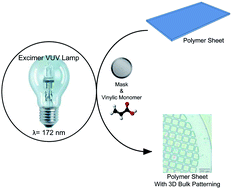To overcome these drawbacks, Berthelot and co-workers proposed here an innovative process, based on VUV irradiation, which proved efficient not only for surface modification, but also for the bulk modification of industrially relevant polymers such as β-polyvinylidene fluoride (β-PVDF), polyethylene (PE) or fluorinated ethylene propylene (FEP). The authors assumed that VUV irradiation of a PVDF film can induce radical active species at depths up to 50 micrometers, as demonstrated by ESR. Those active species were able to initiate the radical polymerization of a vinylic or acrylate monomer such as acrylic acid through the polymer film, as confirmed by the EDX profile of the film thickness. Similar results were obtained on PE and FEP films, while aromatic polymers such as PET strongly absorbed VUV energy and dissipated it along other pathways. By mixing this process and photolithographic masks, 3D structuration of commercial polymer films was also obtained.
VUV grafting: an efficient method for 3D bulk patterning of polymer sheets by Cecile Baudin, Jean-Philippe Renault, Stephane Esnouf, Serge Palacin and Thomas Berthelot Polym. Chem. 2014, 5, 2990-2996.
Julien Nicolas is a web-writer and advisory board member for Polymer Chemistry. He currently works at Univ. Paris-Sud (FR) as a CNRS researcher.











